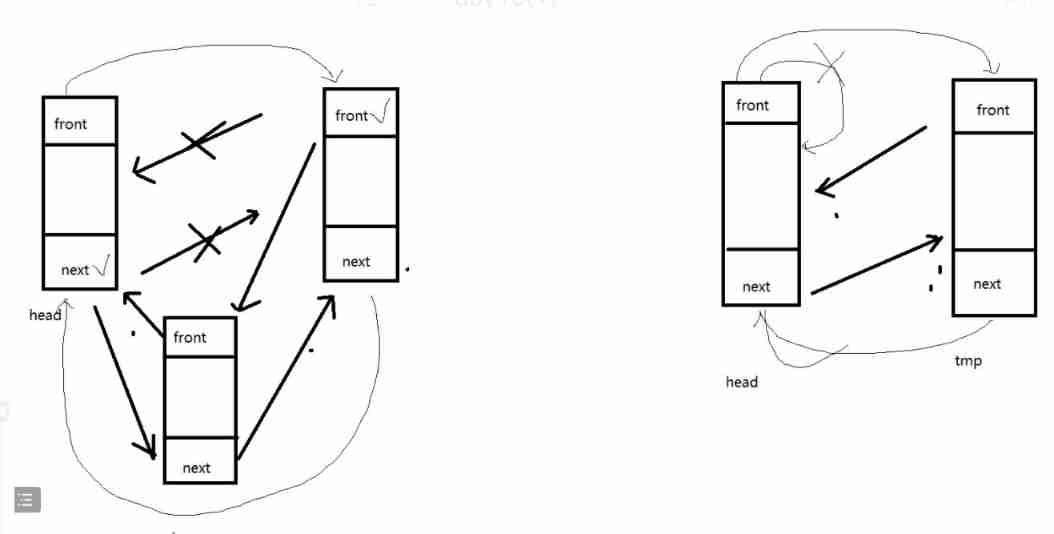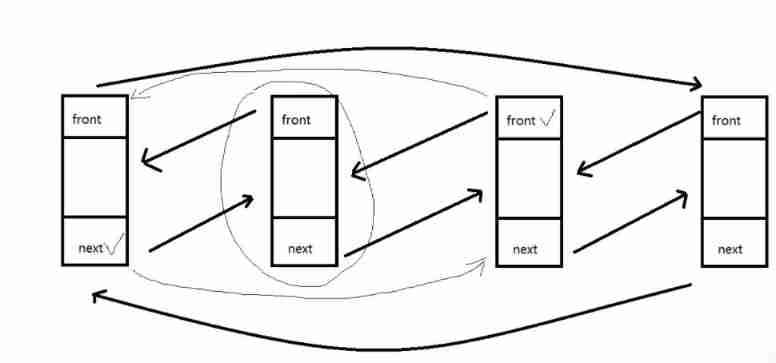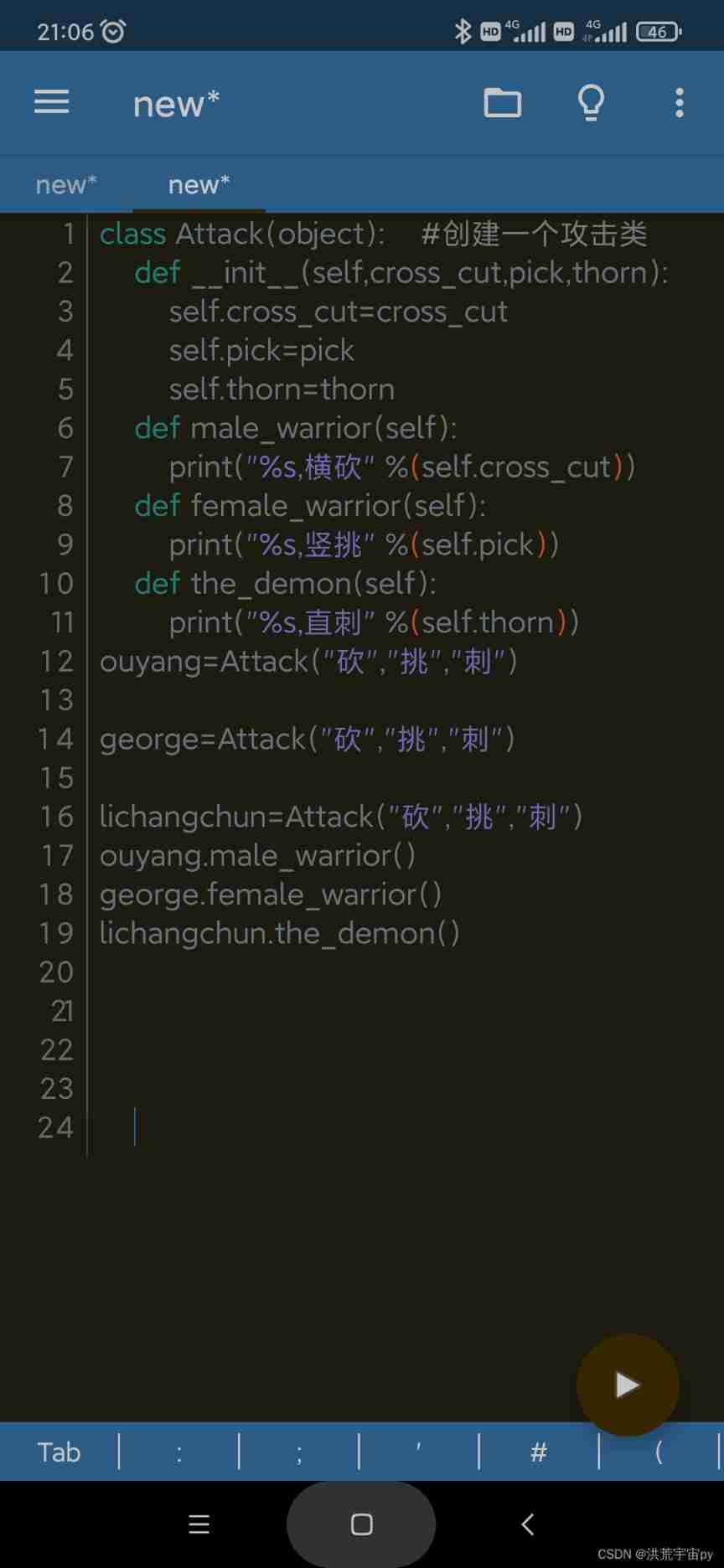当前位置:网站首页>Su embedded training - Day10
Su embedded training - Day10
2022-07-03 18:35:00 【Light chasing rain】
List of articles
One 、 Bidirectional circular linked list
1.1 Concept

1.2 operation
1.2.1 Define a node structure
#ifndef _DOUBLELIST_H_
#define _DOUBLELIST_H_
#include <stdio.h>
#include <stdlib.h>
typedef int DataType;
// Define the node structure
typedef struct doublelist
{
DataType data;
struct doublelist *front; // Save the address of the previous node
struct doublelist *next; // Save the address of the next node
}doublelist;
1.2.2 Create an empty two-way circular linked list
// Create an empty two-way circular linked list
doublelist * DoubleListCreate()
{
doublelist *head = (doublelist *)malloc(sizeof(doublelist));
head->front = head;
head->next = head;
return head;
}
1.2.3 insert data

// insert data
void DoubleListInsert(doublelist *head,DataType value)
{
doublelist *tmp = (doublelist *)malloc(sizeof(doublelist));
tmp->front = NULL;
tmp->next = NULL;
tmp->data = value;
tmp->next = head->next;
tmp->front = head;
head->next->front = tmp;
head->next = tmp;
}
1.2.4 Traversing the linked list
// Traverse the two-way circular linked list
void DoubleListPrint(doublelist *head)
{
doublelist *p = head;
while(p->next != head)
{
p = p->next;
printf("%d ",p->data);
}
putchar(10);
}
practice : Delete data by header deletion

// Delete data by header deletion
DataType DoubleListDelete(doublelist *head)
{
if(head->next == head)
{
printf(" The two-way circular linked list is empty !\n");
return (DataType)-1;
}
doublelist *tmp = head->next;
head->next = tmp->next;
tmp->next->front = head;
DataType value = tmp->data;
free(tmp);
tmp = NULL;
return value;
}
Two 、 Stack (stack)
2.1 Concept
The nature of the stack : Last in, first out
Stack operation :
Push ( Pressing stack )push
Out of the stack ( Single stack )pop
2.2 Order of the stack seqstack
2.2.1 Define data types
#ifndef _SEQSTACK_H_
#define _SEQSTACK_H_
#include <stdio.h>
#include <stdlib.h>
#define N 32
typedef int DataType;
typedef struct seqstack
{
DataType data[N];
int pos;
}seqstack;
#endif
2.2.2 Defining structure
Create a stack
// Create an empty stack
seqstack* SeqStackCreate()
{
seqstack *s = (seqstack *)malloc(sizeof(seqstack));
s->pos = -1;
return s;
}
2.2.3 Determine whether the stack is full
// Determine whether the stack is full
int SeqStackIsFull(seqstack *s)
{
return s->pos == N -1 ? 1 : 0;
}
Judge whether the stack is empty
// Judge whether the stack is empty
int SeqStackIsEmpty(seqstack *s)
{
return s->pos == -1 ? 1: 0;
}
2.2.4 Push
// Push
void SeqStackPush(seqstack *s,DataType value)
{
if(SeqStackIsFull(s))
{
printf(" The stack is full !\n");
return;
}
s->pos++;
s->data[s->pos] = value;
return;
}
2.2.5 Out of the stack
// Out of the stack
DataType SeqStackPop(seqstack *s)
{
if(SeqStackIsEmpty(s))
{
printf(" The stack is empty. !\n");
return (DataType)-1;
}
DataType value = s->data[s->pos];
s->pos--;
return value;
}
2.3 Chain stack ( Chain stack )

The overall code
mian.c
//main.c
#include "linkstack.h"
int main(int argc, char const *argv[])
{
stack s;
InitStack(&s);
push(&s,100);
push(&s,200);
push(&s,300);
push(&s,400);
push(&s,500);
push(&s,600);
push(&s,700);
while(!EmptyStack(&s))
{
printf(" Out of the stack :%d\n",pop(&s));
}
return 0;
}
linkstack.c
//linkstack.c
#include "linkstack.h"
// Initialization stack information
void InitStack(stack *s)
{
s->length = 0;
s->top = NULL;
}
// Push
void push(stack *s,DataType value)
{
if(NULL == s)
{
printf(" Stack space allocation failed , initialization failed !\n");
return ;
}
Node *tmp = (Node *)malloc(sizeof(Node));
tmp->next = NULL;
tmp->data = value;
tmp->next = s->top;
s->top = tmp;
s->length++;
}
// Get stack top element
DataType GetTop(stack *s)
{
if(NULL == s)
{
return (DataType)-1;
}
if(s->top == NULL)
{
return (DataType)-1;
}
return s->top->data;
}
// Out of the stack
DataType pop(stack *s)
{
if(NULL == s)
{
return (DataType)-1;
}
if(s->top == NULL)
{
return (DataType)-1;
}
Node *tmp = s->top;
s->top = tmp->next;
DataType value = tmp->data;
free(tmp);
tmp = NULL;
s->length--;
return value;
}
// Judge whether the stack is empty
int EmptyStack(stack *s)
{
return s->top == NULL ? 1 : 0;
}
// Empty stack
int ClearStack(stack *s)
{
if(NULL == s)
{
return (DataType)-1;
}
if(s->top == NULL)
{
return (DataType)-1;
}
Node *tmp = s->top;
while(tmp)
{
s->top = tmp->next;
free(tmp);
tmp = s->top;
s->length--;
}
return 1;
}
practice Four arithmetic unit

// Determine the priority of symbols
int Priority(char ch)
{
switch (ch)
{
case '(':
return 3;
case '*':
case '/':
return 2;
case '+':
case '-':
return 1;
default:
return 0;
}
}
// Four hybrid calculators
void calculator()
{
stack s_sum, s_opt;
InitStack(&s_sum);
InitStack(&s_opt);
char opt[128] = {
0};
printf(" Please enter the expression :\n");
scanf("%s",opt);
int i = 0,tmp = 0,num1,num2;
while(opt[i] != '\0' || EmptyStack(&s_opt) != 1)
{
if(opt[i] >= '0' && opt[i] <= '9') // Operands
{
tmp = tmp *10 + opt[i] - '0';
i++;
if(opt[i] < '0' || opt[i] > '9')
{
push(&s_sum,tmp);
tmp = 0;
}
}
else // The operator
{
if(EmptyStack(&s_opt) == 1 || Priority(opt[i]) > Priority(GetTop(&s_opt))||
(GetTop(&s_opt) == '(' && opt[i] != ')'))
{
push(&s_opt,opt[i]);
i++;
continue;
}
if(GetTop(&s_opt) == '(' && opt[i] == ')')
{
pop(&s_opt);
i++;
continue;
}
if(Priority(opt[i]) <= Priority(GetTop(&s_opt)) ||opt[i] == ')' && GetTop(&s_opt)!= '('||
opt[i] == '\0' && EmptyStack(&s_opt) != 1)
{
switch (pop(&s_opt))
{
case '+':
num1 = pop(&s_sum);
num2 = pop(&s_sum);
push(&s_sum,num1 + num2);
break;
case '-':
num1 = pop(&s_sum);
num2 = pop(&s_sum);
push(&s_sum,num2 - num1);
break;
case '*':
num1 = pop(&s_sum);
num2 = pop(&s_sum);
push(&s_sum,num1 * num2);
break;
case '/':
num1 = pop(&s_sum);
num2 = pop(&s_sum);
push(&s_sum,num2 / num1);
break;
default:
break;
}
}
}
}
printf("%d\n",GetTop(&s_sum));
}
边栏推荐
- Boost.Asio Library
- Win32: analyse du fichier dump pour la défaillance du tas
- Mysql45 lecture learning notes (II)
- [combinatorics] generating function (use generating function to solve the number of solutions of indefinite equation)
- Software development freelancer's Road
- How to quickly view the inheritance methods of existing models in torchvision?
- Gao Qing, Beijing University of Aeronautics and Astronautics: CIM is a natural quantum computing platform for graph data processing
- Analysis of the reasons why enterprises build their own software development teams to use software manpower outsourcing services at the same time
- Use of unsafe class
- [Tongxin UOS] scanner device management driver installation
猜你喜欢

Have you learned the correct expression posture of programmers on Valentine's day?

Read the paper glodyne global topology preserving dynamic network embedding

Class exercises

Win32: dump file analysis of heap corruption

Nodejs (01) - introductory tutorial

NFT新的契机,多媒体NFT聚合平台OKALEIDO即将上线
![The number of incremental paths in the grid graph [dfs reverse path + memory dfs]](/img/57/ff494db248171253996dd6c9110715.png)
The number of incremental paths in the grid graph [dfs reverse path + memory dfs]
![Bloom filter [proposed by bloom in 1970; redis cache penetration solution]](/img/f9/27a75454b464d59b9b3465d25fe070.jpg)
Bloom filter [proposed by bloom in 1970; redis cache penetration solution]

Torch learning notes (7) -- take lenet as an example for dataload operation (detailed explanation + reserve knowledge supplement)

G1 garbage collector of garbage collector
随机推荐
Torch learning notes (4) -- torch's dynamic calculation diagram
Win 11 major updates, new features love love.
Image 24 bit depth to 8 bit depth
12、 Service management
On Data Mining
Enterprise custom form engine solution (12) -- form rule engine 2
2022-2028 global lithium battery copper foil industry research and trend analysis report
Implementation of cqrs architecture mode under Kratos microservice framework
win32:堆破壞的dump文件分析
Mature port AI ceaspectus leads the world in the application of AI in terminals, CIMC Feitong advanced products go global, smart terminals, intelligent ports, intelligent terminals
Redis core technology and practice - learning notes (11): why not just string
JS_ Array_ sort
A. Berland Poker & 1000 [simple mathematical thinking]
How to analyze the rising and falling rules of London gold trend chart
G1 garbage collector of garbage collector
Torch learning notes (1) -- 19 common ways to create tensor
189. Rotation array
Lesson 13 of the Blue Bridge Cup -- tree array and line segment tree [exercise]
2022-2028 global marking ink industry research and trend analysis report
The number of incremental paths in the grid graph [dfs reverse path + memory dfs]